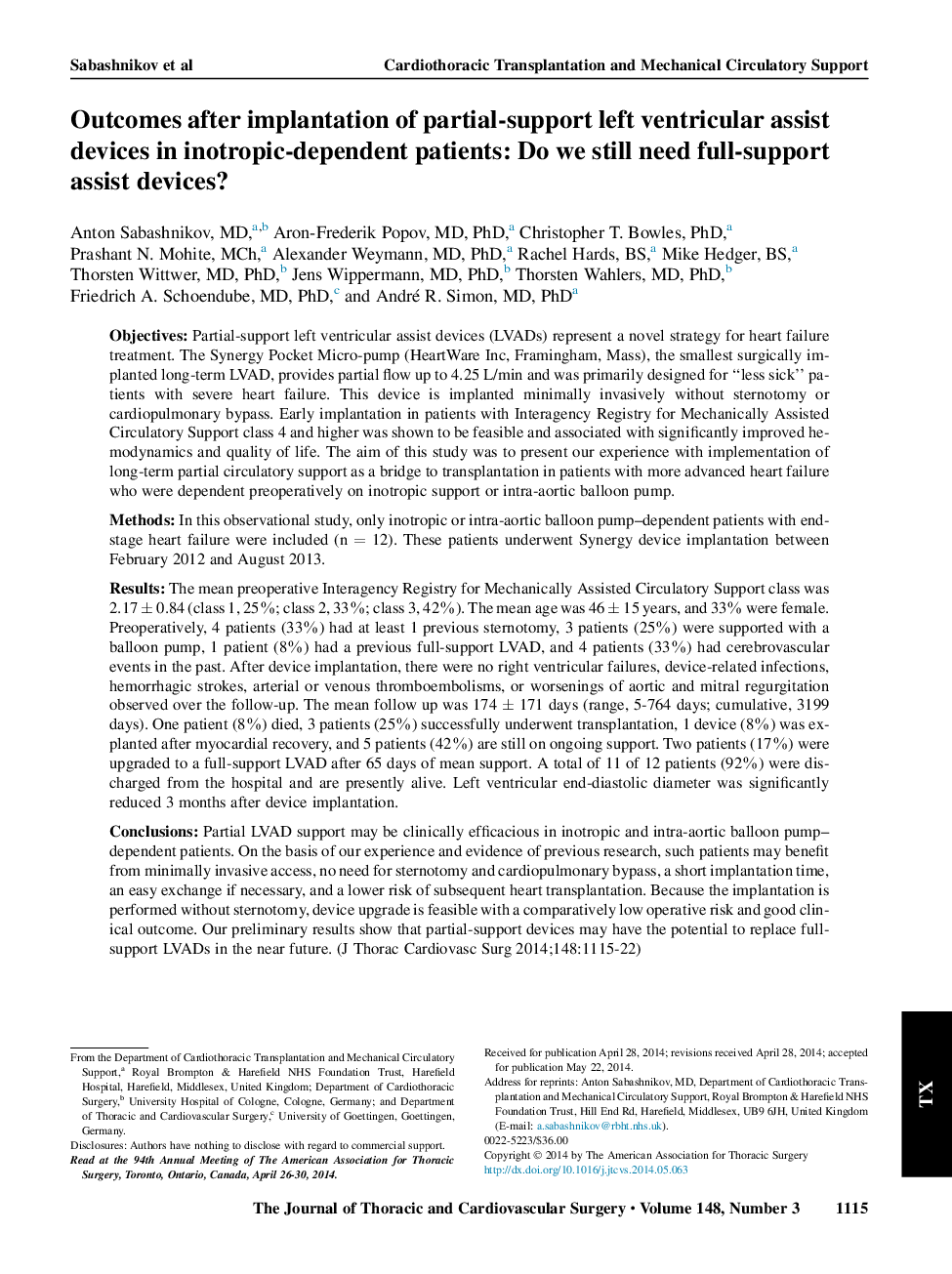| کد مقاله | کد نشریه | سال انتشار | مقاله انگلیسی | نسخه تمام متن |
|---|---|---|---|---|
| 5989388 | 1578607 | 2014 | 8 صفحه PDF | دانلود رایگان |

ObjectivesPartial-support left ventricular assist devices (LVADs) represent a novel strategy for heart failure treatment. The Synergy Pocket Micro-pump (HeartWare Inc, Framingham, Mass), the smallest surgically implanted long-term LVAD, provides partial flow up to 4.25 L/min and was primarily designed for “less sick” patients with severe heart failure. This device is implanted minimally invasively without sternotomy or cardiopulmonary bypass. Early implantation in patients with Interagency Registry for Mechanically Assisted Circulatory Support class 4 and higher was shown to be feasible and associated with significantly improved hemodynamics and quality of life. The aim of this study was to present our experience with implementation of long-term partial circulatory support as a bridge to transplantation in patients with more advanced heart failure who were dependent preoperatively on inotropic support or intra-aortic balloon pump.MethodsIn this observational study, only inotropic or intra-aortic balloon pump-dependent patients with end-stage heart failure were included (n = 12). These patients underwent Synergy device implantation between February 2012 and August 2013.ResultsThe mean preoperative Interagency Registry for Mechanically Assisted Circulatory Support class was 2.17 ± 0.84 (class 1, 25%; class 2, 33%; class 3, 42%). The mean age was 46 ± 15 years, and 33% were female. Preoperatively, 4 patients (33%) had at least 1 previous sternotomy, 3 patients (25%) were supported with a balloon pump, 1 patient (8%) had a previous full-support LVAD, and 4 patients (33%) had cerebrovascular events in the past. After device implantation, there were no right ventricular failures, device-related infections, hemorrhagic strokes, arterial or venous thromboembolisms, or worsenings of aortic and mitral regurgitation observed over the follow-up. The mean follow up was 174 ± 171 days (range, 5-764 days; cumulative, 3199 days). One patient (8%) died, 3 patients (25%) successfully underwent transplantation, 1 device (8%) was explanted after myocardial recovery, and 5 patients (42%) are still on ongoing support. Two patients (17%) were upgraded to a full-support LVAD after 65 days of mean support. A total of 11 of 12 patients (92%) were discharged from the hospital and are presently alive. Left ventricular end-diastolic diameter was significantly reduced 3 months after device implantation.ConclusionsPartial LVAD support may be clinically efficacious in inotropic and intra-aortic balloon pump-dependent patients. On the basis of our experience and evidence of previous research, such patients may benefit from minimally invasive access, no need for sternotomy and cardiopulmonary bypass, a short implantation time, an easy exchange if necessary, and a lower risk of subsequent heart transplantation. Because the implantation is performed without sternotomy, device upgrade is feasible with a comparatively low operative risk and good clinical outcome. Our preliminary results show that partial-support devices may have the potential to replace full-support LVADs in the near future.
Journal: The Journal of Thoracic and Cardiovascular Surgery - Volume 148, Issue 3, September 2014, Pages 1115-1122